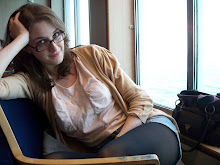
Tuesday 3rd November; a slow afternoon, so off we went to the Conerhouse with a plan to see Wes Anderson's latest film, Fantastic Mr. Fox. Which is already a wonderful story by one of my favourite children's authors, Roald Dahl.
As a child I loved his books but I especially adored Quentin Blake's beautiful illustrations. To me they appear delicate, random, and full of movement. The detail of each drawing is captivating. He uses inks and watercolours as washes to add colour, and despite the chosen media, the illustrations hold amazing vibrancy on the page.
Fantastic Mr. Fox is a piece of stop-motion animation work, made entirely with models for all of the characters. Each scene was painstakingly crafted, usually involving several models. Of course it was highly time-consuming for the entire film to be completed. Apparently it was all shot using a Nikon D3 which has a higher resolution than that of full High Definition. It was shot using a rate of 12 frames per second rather than 24 frames so the viewer was more aware of the stop-motion. I think the enhanced stop-motion adds even more charm to the film.
Fantastic Mr. Fox is a piece of stop-motion animation work, made entirely with models for all of the characters. Each scene was painstakingly crafted, usually involving several models. Of course it was highly time-consuming for the entire film to be completed. Apparently it was all shot using a Nikon D3 which has a higher resolution than that of full High Definition. It was shot using a rate of 12 frames per second rather than 24 frames so the viewer was more aware of the stop-motion. I think the enhanced stop-motion adds even more charm to the film.
I also really enjoy Wes Anderson's other films. Fantastic Mr. Fox was lively and brilliant, but others; The Darjeeling Limited and Rushmore are also favourites of mine. The Darjeeling Limited is about 3 brothers journeying through India on a train and how the country is filmed is extraordinary. It truly captures the essence of the culture and amazing scenery.




